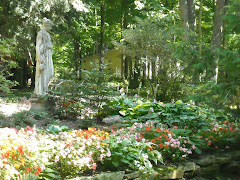Spring Cleaning in the Great Outdoors
The weather this past weekend made me stop and question if it was really the end of April and not late October. Like so many of my fellow "greenthumbers" I woke up Saturday morning eager to tackle my spring cleanup list and found snowflakes in the air… Yikes! However, buds are breaking and grass is greening and a little wind and snow was no match for the powerful urge to get out in the garden. There is much to do and this is Wisconsin after all... We can handle it!
Yes, it's time for the main event in the gardener's annual rite of spring… "The spring cleanup". Which includes pruning, deadheading, thatching, fertilization, mulching, and finally applying a pre-emergent herbicide on the freshly mulched beds. It is amazing what a small investment and a little bit of elbow grease can do to improve the health and appearance of your lawn and garden.
OK, here are a few tips to get you started;
Pruning – Shrubs grown primarily for foliage, (alpine currant, barberry, burning bush, dogwood and ninebark), should be pruned in early spring before growth begins. Spring and early summer blooming trees and shrubs, (azalea, chokeberry, forsythia, lilac, and spirea), should be pruned immediately after their bloom time. Next, it's time to clean up the perennials and grasses in the garden. – Cut away the dead leaves and foliage it is important to remove the cuttings and branches from around the base of the plant prior to mulching which will help reduce the possibility of pests or disease. Continue "deadheading" (cutting the spent flowers from your perennials) throughout the growing season to prolong blooms or encourage re-blooms. In the case of spring bulbs, once the plant has flowered, I suggest trimming only the yellow or brown plant material, rather than cutting the plant off at the base. This may require several visits with the pruners, but by doing this it will allow the transfer of vital nutrients to return to the bulb. Oh, and don't forget the area around the receding tulips and daffodils makes a wonderful spot for petunias, and other colorful annuals.
Next you are ready to divide and transplant your summer and fall blooming perennials - Many of our favorites require dividing sometime within two to five years of their initial planting. This is a bonus for garden enthusiasts. Some of my favorite plants in my garden were gifts from friends that had divided their prize irises, daylilies and grasses. Typically, Stella d' Oro daylilies should be divided by their third spring to revitalize their blooms. However, other perennials require dividing at different intervals depending on the species. For further information and a comprehensive list of spring perennials and the recommended division times, please visit our website - www.livingcolorlandscapes.net
Next, you are ready to fertilize your plants with a low-salt organic fertilizer. If you happen to live near a watershed, you will want to watch the phosphorous content as well. And finally, it is time to top dress the planting beds with double shredded hardwood mulch and apply a granular pre-emergent herbicide. This will give your garden a rich, neat appearance, encourage healthy soil and help you to retain valuable moisture while preventing the spread and germination of weeds. Take caution to avoid piling the mulch up against the stem of the plant. I suggest an inch and a half clearance for shrubs and perennials. One note on pesticides… "If hiring out this service, it is important to use licensed applicators". In the state of Wisconsin, anyone who applies any pesticide for hire must be licensed as a commercial applicator. According to Lawn and Garden News…The definition of a pesticide is "a substance or mixture of substances used to destroy or control any undesirable form of animal or plant life… The pest can be mice, flies, bacteria or even weeds. "A licensed applicator will ensure that safe practices are being followed. Check with your landscape professional.
So relax, roll up your sleeves and embrace this wonderful blessing called spring. With a little effort now you will enjoy a beautiful outdoor environment all season long.
James "Motor" Merritt – Partner & Creative Director
Living Color Landscapes






No comments:
Post a Comment